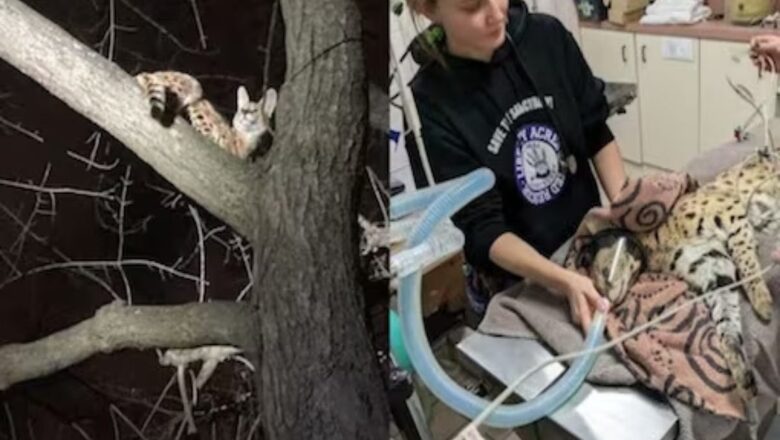
views
Cocaine Bear is a 2023 American movie loosely inspired by the true story of an American black bear, weighing around 200 pounds, found in a Georgia forest, that had ingested nearly 3 to 4 grams of cocaine, sufficient to kill a person.
The cocaine was apparently dropped from a plane piloted by Andrew Thornton, a convicted drug smuggler, who got killed while parachuting, as he was carrying too heavy a contraband. Thornton was a notorious drug smuggler and a former police officer. He was found dead the morning of September 11, 1985, in the backyard of a house in Knoxville, Tennessee, wearing a parachute and Gucci loafers. He had several weapons and a duffel bag containing about 35 kilograms of cocaine valued at $15 million. A key found in his pocket matched the tail number of a wrecked plane that was found in Clay County and based on Thornton’s history of drug smuggling, investigators guessed there was more cocaine nearby. The investigators searched the surrounding area and found more than 300 pounds of cocaine in a search that lasted several months. They also found the dead bear, whose stuffed body is now kept on display at Lexington, at the Kentucky Fun Mall.
Andrew Carter Thornton was born in 1944, he was the son of a prominent Kentucky horse breeder and became an expert paratrooper for the US Army, even earning a Purple Heart when the US invaded the Dominican Republic in 1965. Thornton left the Army that same year and returned to Kentucky, where he joined the Lexington Police Department’s narcotics squad. However, he got involved in the drug trade.
But did the bear get high from the cocaine? It’s unclear—and scientists are unsure whether any animal experiences the same type of high that humans do from substances like alcohol, marijuana, or cocaine.
In March 2023, an incident came to light of an exotic cat, rescued from a tree in Ohio, which tested positive for cocaine. The exotic animal was identified as a Serval which are medium-sized wild cats native to sub-Saharan Africa. The Serval, named Amiry, was rescued after escaping from a vehicle during a police stop and climbing a tree. The cat’s owner had been pulled over by police for a traffic violation. Rescue workers noted that the cat appeared highly agitated. It fell from the tree during the rescue attempt and fractured its leg. At the animal shelter, the staff took a sample for a DNA test and also tested the cat for narcotics, which turned out to be positive! They started regularly testing exotic animals for narcotics after an incident in which they seized a capuchin monkey who tested positive for methamphetamine. The wild cat is now under the care of the Cincinnati Zoo.
Kerala is facing a unique problem of violent behaviour by stray dogs. The Kerala State Commission for Protection of Child Rights has moved the Supreme Court, saying increasing stray dog attacks on children, often with fatal results, and inaction on the part of state authorities is a violation of child rights. The Supreme Court in July 2023 orally said that there has to be an enduring solution to the issue of stray dogs in Kerala.
Why is it that only in certain places in Kerala the stray dogs are behaving violently? Generally, stray dogs are docile and avoid humans. These starving animals live on whatever morsels of food they can salvage from the garbage. How is it that they become hyper-aggressive only in some towns? Such abnormal behaviour is reported mostly from Kerala, why? Could there be a drug connection? Researchers found that dogs are susceptible to opioid poisoning. Marijuana toxicity can disable and even kill cats and dogs. Animal shelters in the US have reported that dogs are being injected with heroin to make them more aggressive and are trained to attack anyone in a police uniform. The drug dealers get the dogs addicted to the drugs and then withhold the drugs, forcing the dog to go through ‘heroin withdrawal’. The dogs become aggressive and behave dangerously. Of late, Kerala has been reporting regular seizures of synthetic drugs, from users, especially students. The chances of pets or even stray dogs ingesting drugs accidentally or being fed intentionally appear quite possible.
The ‘Heroin Dogs of Kabul’ is the reality of stray dogs in the streets of Kabul being fed heroin deliberately. Not only does it put dogs at risk of a lethal overdose, but it can cause long-term toxicity to the liver and have profound negative effects on their life. There is little research on the effect of heroin on canines, as well as how morphine is metabolised by dogs. But many doctors hypothesise that dogs might experience a transient sense of euphoria on absorption of the drug. Like in the case of humans, heroin was found to have profound physiological effects in dogs such as severe depression of blood pressure, heart rate and breathing rate. Heroin can cause a markedly reduced concentration of oxygen in the blood, a condition called hypoxia which can lead to muscle pain, brain damage and organ failure.
In Kerala, it can be the case that stray dogs are being given food laced with drugs to make them aggressive and fearful. The sporadic and intermittent aggression among dogs from different locations in the state gives rise to the suspicion that there is some malafide motive, at work. It may be the intention to coerce the government into taking action to cull the helpless dogs.
In September 2023, in Kottayam, Kerala, a state Anti-Narcotics squad, acting on a tip-off about a suspected drug dealer, was surprised to confront aggressive dogs specifically trained to attack anyone daring to wear khaki clothing. It took nine police officers some time to subdue thirteen dogs, including Pitbulls and Rottweilers. The Police seized about 17.3 kg of ganja from the house.
Intoxication of pets with recreational (or illicit) drugs has become more common over the last decade. Exposure to illicit drugs can be accidental, intentional, or malicious. Also, due to the wandering trait and non-selective appetite, dogs are prone to any type of poisoning, including poisoning by illicit drugs. In dogs, opiate drugs can cause sedation and decreased responsiveness through weakness, stumbling, collapse, shallow breaths, low heart rate and loss of consciousness. Not only stray dogs but even police dogs and dogs maintained by other enforcement agencies are at risk because they come in contact with large quantities of high-purity chemicals during training and search operations. Because of the illegal nature of illicit drugs, diagnosis can be rather difficult. Furthermore, illicit drugs are often adulterated i.e. combined or contaminated with other pharmacologically active substances, making the diagnosis even more difficult. Some pharmacologically active substances, often found as impurities, are more toxic to pets than humans, like caffeine.
Dogs have more cannabinoid receptors in their brains, hence the effects of cannabis are more dramatic and potentially more toxic when compared to humans. A small amount of cannabis is all it takes to cause toxicity in cats and dogs. It is sad that humans are making cats and dogs to be drug ‘connoisseurs’.
The writer is a retired officer of the IRS and the former director-general of the National Academy of Customs, Indirect Taxes & Narcotics. Views expressed in the above piece are personal and solely that of the author. They do not necessarily reflect News18’s views.




















Comments
0 comment